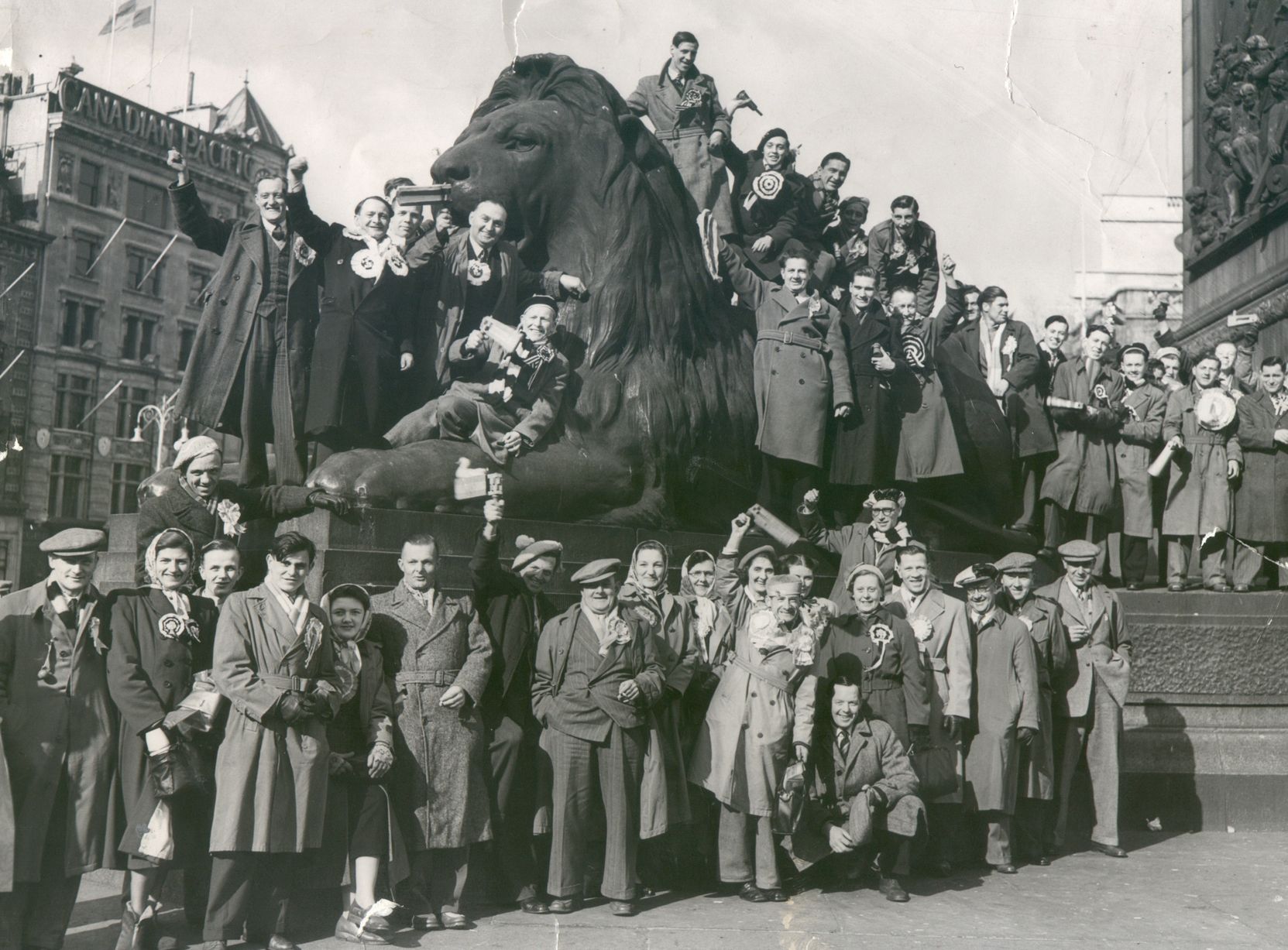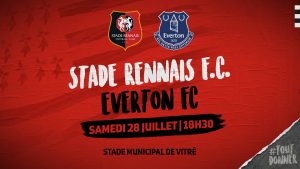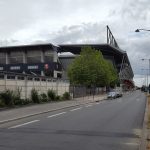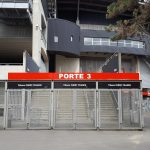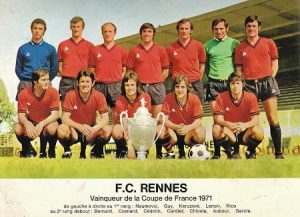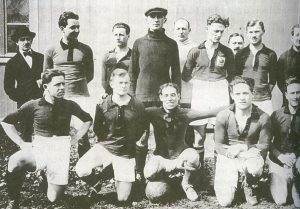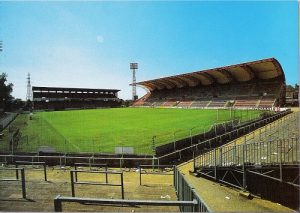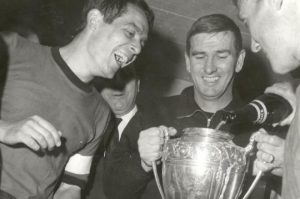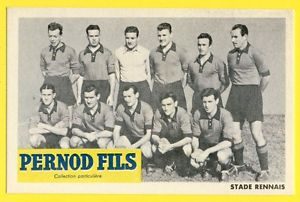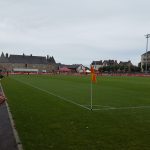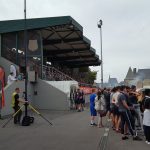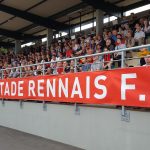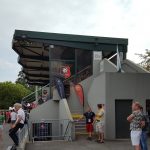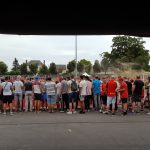Stade Rennais 4 Everton 1
Friendly
28 July 2018
The context
If you’re on holiday near Rennes and you hear that Everton are playing Rennes you tend to imagine the game will take place at the Rennes stadium. This assumption proved wrong. Roazhon Park was completely deserted and it took some quick Googling, in French, to discover the match was actually happening thirty miles away. Stade Rennais presumably have some kind of deal going with their Championnat National 2 neighbours AS Vitre, akin (say) to the Chelsea arrangement with Wimbledon – and the Blues were (equally presumably) felt worthy only of a reserve stadium in a sleepy village. C’est la vie, as the locals never say.
These pictures therefore show a very quiet Roazhon Park. The ground used to be known as Stade de Route de Lorient – or, more prosaically, Lorient Road. Roazhon is the Breton word for Rennes. Totally rebuilt in 2001, Roazhon has nearly 30,000 seats in well-designed if rather prefabricated stands.
- coming along….
- ….the Lorient Road
- to see the Stade Rennaisses
- Roazhon Pork
- soldiers
- staircases
- portico
- porte
- curved
- climbing
- steel
- strolling
The history
Remember when French exchanges provided 14 year-olds with low-cost holidays in the homes of equally disinterested teenagers from the other side of the Channel? In Exeter we were twinned with Rennes. We got to drink wine at the table on the away leg, but the payback was a Gallic invasion of shrugging Kickers-wearing moptops who wasted no time pulling every half-way eligible girl in the school. Our exchange students seemed particularly streetwise and sophisticated. This was probably (had we known it) down to the French city’s status as a post-punk hotbed. Local heroes Marquis de Sade had released Dantzig Twist in 1979, and Rennes’ reputation as the teenage rebellion capital of France was established by these New Wave pioneers and imitators such as Marc Seberg and Les Nus.
The Rennes football scene was rather less chic. The Rennais had been relegated from the French first division in 1975 and found themselves struggling to stave off bankruptcy. This represented a spectacular decline for one of the country’s most charismatic teams. Winners of the Coupe de France in 1965 and 1971 under talismanic manager Jean Prouff, they had taken part in high-profile European ties against Dukla Prague and Rangers. The Stade de Route de Lorient was a modern, functional ground. But things went wrong after Prouff retired – the city council were obliged to take control, triggering a period of austerity that lasted until the 1990s when a thriving academy began producing quality home-grown players (Sylvain Wiltord being the best-known). Nowadays the club is owned by Breton billionnaire Francois Pinault. He has invested heavily in both infrastructure and stadium improvements.
That 1965 triumph (decided by goals from the prolific Daniel Rodighiero) was a third attempt to lift the trophy. It followed defeats to Red Star Amical in 1922 and Marseille in 1935. The 1922 final featured two teams with similar origins and idealogies – the socialist radicals of Red Star, an intellectual cabal founded by Jules Rimet in 1897, and the no less earnest arrivistes of Stade Rennais Universite-Club. Stade had been created in 1901 by a group of students including Ghis, Duchesne, Jamin, Peter, Mafilatre, Audren and Langilier. They merged with the anarcho-syndicalists of FC Rennais and chose red and black colours symbolising republican and Catholic sympathies. Their first manager was a Welshman, Arthur Griffiths. His legacy was to establish the club by breaking the hegemony of their great rivals, the British-dominated and St Malo-based US Saint-Servan.
The stadium has – unsurprisingly – seen a few changes during its 108-year existence. The Rennais originally moved there because they were fed up of their first home at Mabilais (on the opposite bank of the River Vilaine) flooding every time it rained. At the time of the Exeter-Rennes exchange there were American-style bleachers behind each goal and 1950s-era concrete grandstands on the Vilaine and Rue De Lorient sides. But things went seriously avant-garde in the Eighties, when the Council were faced with the need to make essential repairs to these brutalist structures and responded with a grandiose plan to build a mini version of Munich’s Olympiastadion. This would have featured lightweight canvas roofs supported by steel beams. But as so often happens they only built one stand before the money ran out, and despite its undoubted magnificence the bright new addition served only to make everything else look even more shabby.
Those penurious times seem a long way in the past. Roazhon is positively luxurious nowadays and the smartest lounge of all has been named after the inimitable Prouff, who managed the club for nine years and played there in three separate spells during a career interrupted by World War 2. Returning in 1944 to a newly-liberated city and a ground being used as a storage depot by American forces, the midfielder was given his first international cap in an unofficial game against the British Army. He cycled to Paris, taking two days, and arrived just in time for the warm up – at which the goalkeeper, Lille’s Julien Darui, exclaimed “T’as le culot de t’échauffer avant le match quand tu viens de te taper 300 kilomètres en vélo?!”
The visit
Breton roads are well-signposted and despite some nonsense with a half-built by-pass near La Louvais we roared into Vitre with time to spare. The few people we could see were heading purposefully across the grounds of the Ibis Hotel, and so – abandoning the car on a handy verge – we followed the crowd to a small sports centre. There we enquired about “les billets” and, having no wish to be shoved into whatever rudimentary away end this place possessed, denied any allegiance to Everton whatsoever. Neutrality proven we were then directed to a makeshift ticket office consisting of a desk inside a lorry container, parted with ten Euros each and were in.
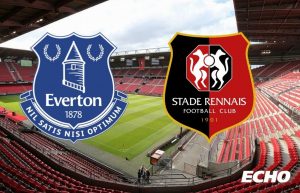
short notice
The game had been arranged at short notice and there were a hundred away fans at most. As suspected they’d been hurriedly corralled into a makeshift pen made from temporary wire fencing with some gendarmes, a hot-dog stand and a lager tap for company. Things were rather more palatial behind the home goal. Here we found several bars and a full-scale mediaeval feast featuring a hog roast and enough sausages to feed an army. A barbecue smoke-screen billowed across an open area where fans sat in deckchairs under marquees and children bought souvenirs, posed with a giant ermine and took penalty kicks against youth players. Everything was pop-up, portable or inflatable. It felt more like a summer fete than a football match.
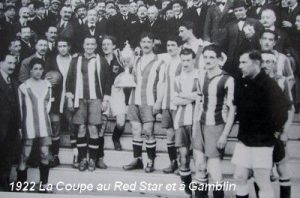
Star men
The Stade Municipal in Vitre opened in 1922, 15 years after the Amicale Sportive club was formed by local dentist M. Venturino. The inaugural game was between ASV and – fresh from their victory over Rennes at Stade Pershing – the Cup-winners of Red Star. The ground is next to the Chateau Marie, a 17th century castle. Anywhere else this would be a big deal but Vitre – described by Victor Hugo as “a Gothic city entire, complete, homogeneous” is overflowing with fine architecture. The stadium has a definite non-League vibe but the team are actually professional members of the French fourth tier. Due to its limitations recent big games involving the Sang et Or (literally, “gold and blood) have been staged at Roazhon, notably Coupe de France ties against Lyon in 1997, AC Ajaccio in 2003 and Lille in 2006.
Today was a relaxed occasion. Smoking and drinking within sight of the pitch aren’t regarded as cardinal sins here. Neither has high-viz jobsworthery reached the French lower leagues, so the players were unusually accessible (although you sensed some were happier with this situation than others). The stewards did object to one fan joining the Everton team for their warm-down, but they only cottoned on during his second circuit of the pitch and even then he was allowed to escape through an open gate after a mild telling-off.
- hot ticket
- les hermines
- talk of the town
- warming up
- film buffs
- big Dunc
- prenez garde
- en attendant
- team news
- photo opportunity
- lining the rails
- standing room only
- crowd scene
- keeping score
- seats taken
- le chic
- bystanding
- snap happy
- the law looks on
- goal no.4
The game
From an Everton perspective the afternoon promised the twin novelties of Marco Silva on the bench and Richarlison on the park. Silva’s first game had ended with an emphatic 22-0 win over some distinctly average Austrian part-timers, but there was a feeling that the Rouge et Noir might prove more challenging opponents. And this was the way the first half unfolded, as the Blues – in shirts so shiny and new the players’ and sponsor’s names hadn’t yet been added – fell 2-0 behind to some excellent finishing. A wicked low ball across the box from the wriggly James Lea-Siliki did the damage in each case, Benjamin Borigeaud and then Theoson Siebatcheau profiting from defending so languid that walking pace would have been an improvement. Stekelenburg in the visitors’ goal was left ruefully pulling up his socks as though they were somehow to blame.
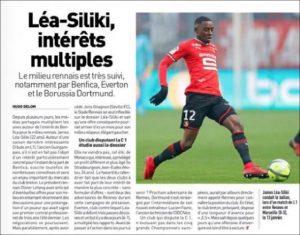
Siliki skills
There were signs of a revival either side of the break. Things hung in the balance for a time after Richarlison followed up his persistence and strength on the edge of the area with a crisp finish across Tomas Koubek. But the game became stretched as both managers and Silva in particular meddled with their line-ups – and the Rennais held their shape better and delivered a knock-out blow with two goals in a minute close to time, both crisp cross-shots across Stekelenburg from inside the box. Faitout scored the first from the right with his left, the deserving Lea-Siliki notched the other from the left with his right. It gave the scoreline an emphasis few in the crowd would have disputed.
Starting line-ups and goals
Stade Rennais: Koubek, Traore, Gelin, Mexer, Baal, Lea-Siliki, Andre, Zeffane, Grenier, Bourigeaud, Siebatcheu.
Everton: Stekelenburg, Coleman, Keane, Jagielka, Baines, Gueye, Schneiderlin, Ramirez, Sigurdsson, Richarlison, Tosun.
Goals: Stade Rennais: Bourigeaud 28, Siebatcheu 36, Maouassa 77, Siliki 79. Everton: Richarlison 45.
Attendance: 3,000.

